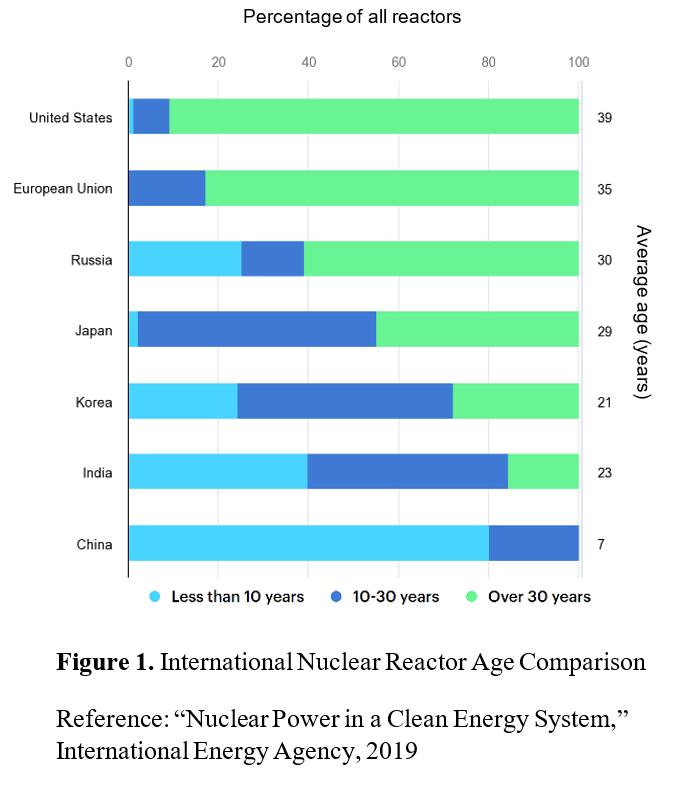
13 minute read
The Argument for Nuclear Power Expansion
Virginia Policy Review 39
By Jonathan Dove
Advertisement
The Nuclear Decline
Since about 1990, nuclear energy has fallen out of favor in the United States. Enactment of the Department of Energy Organization Act by President Jimmy Carter severely limited the United States’ ability to reprocess nuclear fuel, a decision which no other nation with nuclear power generation technology chose to immulate (Frazier, 2017). In short, this decision resulted in higher nuclear plant operating costs, which all but eliminated financial incentives to begin new plant construction within the United States. As a result, nations around the world began nuclear expansion (most aggressively China and Russia), while plants in the U.S. slowly diminished over the same thirty year period.
The United States currently finds itself at a decisional crossroad in terms of how to proceed with nuclear energy policy. As seen in Figure 1, the United States has the oldest nuclear reactors (based on an average age of 39 years) compared to any other country in the world (International Energy Agency, 2019). This statistic might not be cause for alarm if nuclear reactor age was of no consequence. However, the Nuclear Regulatory Commission (NRC) issues 40-year operating licenses to newly commissioned plants. Plants may apply for 20-year license extensions if they meet the NRC’s
40 Volume XV, Issue I, Spring 2022
strict safety requirements (U.S. Nuclear Regulatory Commission, 2018). Thus, it is clear that most reactors in the U.S. are approaching their expiration date. Most plants will likely elect to apply for license extension, but U.S. nuclear reactors have never surpassed the 52-year-old mark to date (U.S. Energy Information Administration, 2021). The U.S. is rapidly approaching a crucial decision point to either abandon nuclear energy or significantly invest in maintaining or expanding its use. To better understand the complexity of this decision, it is helpful to consider nuclear energy’s advantages and disadvantages.
Does Nuclear Power Deserve a Second Chance?
Nuclear Power and the Environment Views on nuclear energy proliferation can be thought of as an environmental “Catch-22.” Nuclear power plants produce unrivaled energy volumes when compared to other popular energy options. Ten grams of uranium (nuclear fuel) provides the same energy as one ton of coal, 17,000 cubic feet of natural gas, or 149 gallons of oil (Nuclear Energy Institute, 2021). Apart from the relatively low CO2 emission levels resulting from uranium mining and enrichment, nuclear power plants emit zero carbon dioxide during operation (U.S. Energy Information Administration, 2020). Thus, nuclear energy seems to be the silver bullet to satisfy both rising electricity demands and the global de-carbonization effort. Unfortunately, nuclear energy has a few obvious downsides. Upon decommissioning, nuclear power plants must bury radioactive materials in deep underground repositories for hundreds of years to prevent environmental damage. Local support for repository siting is traditionally difficult to obtain. Research in Sweden indicates that repository siting is most readily accepted in communities that economically benefit from the nuclear energy industry (Sjoberg, 2004). The highly infrequent, yet immeasurably catastrophic examples from Chernobyl and Fukushima are clear examples of the high-stakes environmental risks associated with nuclear power generation. Media portrayals of nuclear accidents tend to incite fearful reactions among observers without contextualizing the safety risks of other energy production methods. For example, when mortality rates are calculated based on the number of deaths per billion kilowatt-hours produced, nuclear energy has the lowest mortality rate across all energy production sources (Brook et al., 2014). Even so, nuclear
Virginia Policy Review 41
energy carries with it negative preconceptions from a few dangerous accidents. A study examining global sentiments toward nuclear energy following the Fukushima disaster in Japan found the Fukushima catastrophe generated public distrust toward nuclear energy across the globe (Kim et al., 2013). The Increasing Demand for Electricity According to the U.S. Energy Information Administration (EIA), worldwide energy consumption is expected to increase by about 50% between 2018 and 2050, with electricity generation expected to increase 79% during the same time period (U.S. Energy Information Administration, 2019). This anticipated demand increase for electricity is largely attributable to global quality-of-life improvements and a shift within transportation sectors from fossil fuels to electric transit. Figure 2 illustrates the projected share of worldwide electricity consumption by source through 2050. If environmental pressure produces meaningful reductions in fossil fuel consumption, energy producers in all sectors will have to increase output to keep up with global energy demand.
Perhaps the most common solution offered in reaction to this issue is to assert that renewable energy technologies should fill future energy demand expansions. There are, however, several limitations related to renewable energy that should give policymakers pause. Renewable energy is criticized as having a declining return on investment due to equipment efficiency loss over time, the ever-increasing scarcity of prime wind and solar sites, and anticipated reductions in renewable energy subsidies (Moriarty & Honnery 2016). According to Pickard (2014), renewable energy technologies will not be able to meet future demand utilizing current power grids. The intermittent limitations of renewable energy will require an upgraded power grid and energy storage infrastructure to be built, vastly offsetting the perceived
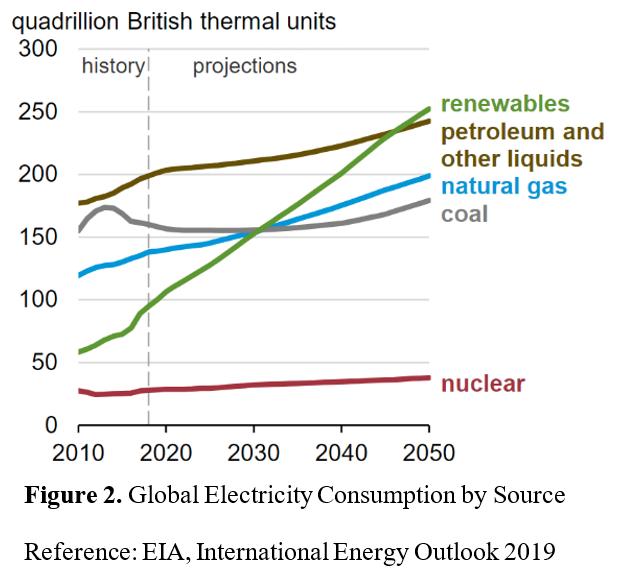
42 Volume XV, Issue I, Spring 2022
benefits of renewables over the next century. There is also ripe irony in reducing non-renewable fossil fuels to pursue renewable energy expansion which depends upon non-renewable materials such as copper, aluminum, and iron. Harmful extraction methods coupled with over-reliance on Chinese rare earth metals make renewable energy less attractive environmentally, economically, and from a national security perspective (Jeffries 2015). Nuclear Power and National Security Recent national events may lead the United States to continue its renewed focus on resilient energy sources and energy independence. The winter storm which struck Texas in February 2021 caused many Americans to question renewable energy’s reliability. Texas has an independent power grid which relies heavily on natural gas to heat and power infrastructure across the state. When freezing temperatures swept across Texas in mid-February 2021, over four million residents were without heat or electricity (Douglas, 2021). Renewable energy sources also came under criticism when Texan wind turbines froze and could not be relied upon for power. The hard lesson Texas learned could inform U.S. energy policy moving forward. The fact that nuclear power generation can function as a primary or alternate power source for critical infrastructure should not be ignored. Nuclear energy is also being recommended as a more reliable means to power remote military bases in Guam or Alaska where importing fossil fuels can be expensive and logistically complex (Holgate & Saha, 2018).
A discussion on nuclear energy proliferation and national security would be incomplete without also including the recent nuclear export campaigns which Russia and China have undertaken. U.S. nuclear exports screeched to a halt in the late 1980s, but Russia and China have aggressively exported nuclear energy supplies around the world to fill the demand of the market (see Figure 3). Russia has attempted to increase
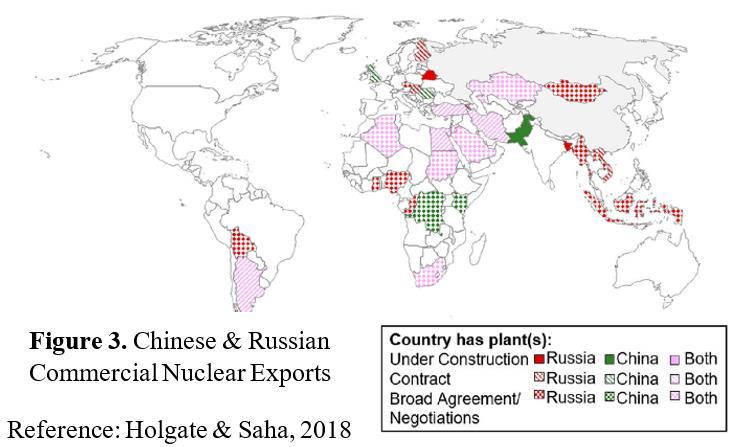
Virginia Policy Review 43
European dependence upon its gas and nuclear power supply chain for several years (Siddi, 2020). China continues to provide nuclear exports to countries which strategically favor its Belt and Road Initiative (Holgate & Saha, 2018). These aggressive global energy moves place China and Russia in more strategic diplomatic positions than the U.S., especially in Asia where most of the projected energy demand will develop over the next 30 years (U.S. Energy Information Administration, 2019).
Gauging Public Support
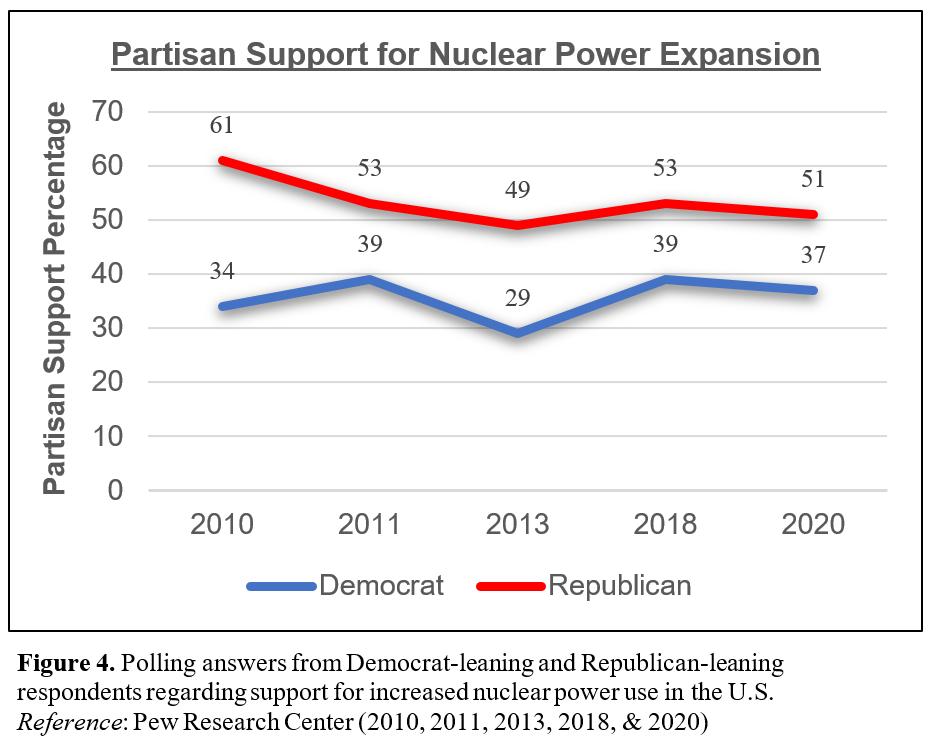
Public support for nuclear power expansion in the United States has remained relatively flat over the last decade. Public opinion poll data indicates that Democrats and Republicans are usually separated by about fifteen percentage points in their support levels for nuclear power expansion (Pew Research Center 2010, 2011, 2013, 2018, & 2020). On average, about 35% of Democrat-leaning respondents and just over 50% of Republican-leaning respondents supported increased nuclear power use when interviewed between 2010 and 2020. This gap increased to a twenty percentage point difference in 2013, the year when public support was at its lowest. These low support levels can be attributed, at least in part, to the Fukushima nuclear disaster in March of
44 Volume XV, Issue I, Spring 2022
2011 when support for nuclear energy decreased worldwide (Kim et al., 2013). The aggregated public opinion poll data shown in Figure 4 appears to reveal a disparity reduction over time between Republicans and Democrats, but increased future data is required to confirm this trend. Particular attention should be paid to Democrat-leaning respondents in future opinion polls since a break from this subgroup’s general flat-line support level could indicate future support directionality. There are also generational differences in public support for expanding various energy sources. The Pew Research Center published findings in 2020 showing that U.S. adults in “Gen Z” and “Millennial” age groups were more likely than “Gen X” and “Baby Boomers” to support complete fossil fuel phase out in favor of renewable energy sources (Funk & Tyson, 2020). Figure 5 illustrates the disparities across age groups, revealing that younger Americans increasingly support eliminating fossil fuel use nationwide. About 75% of respondents in the “Baby Boomers and Older” age group favor a mix of energy sources to include fossil fuels, whereas the two youngest adult groups are approaching majority support for fossil fuel phase out. Absent from this polling question was a specific reference to nuclear energy. Nuclear energy does not fit perfectly as a renewable energy source, but it could see similar hikes in future public support since nuclear power plants emit zero carbon dioxide during operation (“Nuclear Explained,” 2020).
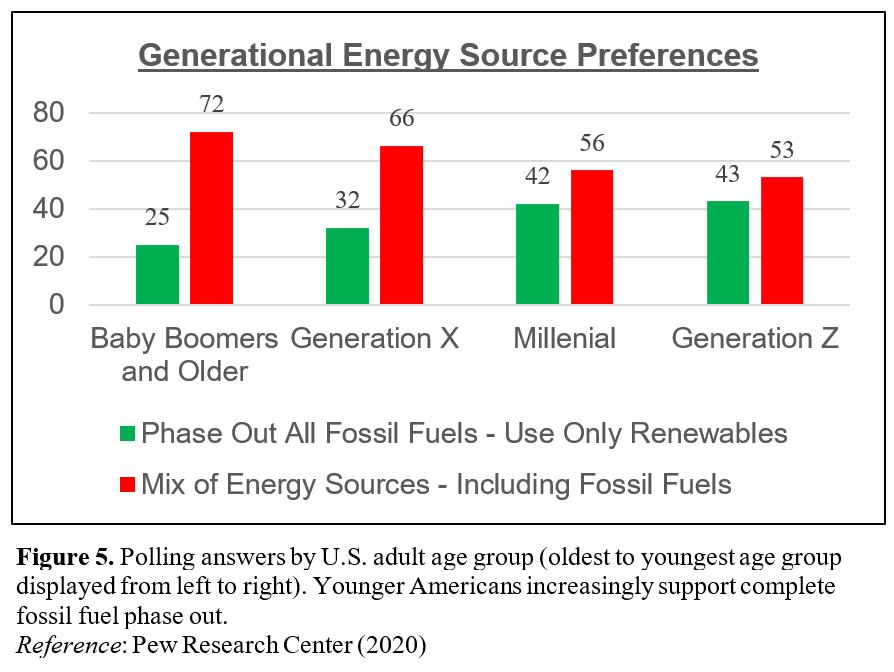
Virginia Policy Review 45
Is It Too Late to Innovate?
As mentioned at the beginning of this article, federal regulation and policy changes in the 1970s and 1980s made commercial nuclear energy production financially untenable. The traditional nuclear power plant may, in fact, become an artifact of the past as operational U.S. reactors near the end of their shelf-life and new construction appears to be virtually over. However, the Massachusetts Institute of Technology (MIT) released a study in 2018 which offered recommendations aimed at making nuclear power generation affordable. The study emphasized the need to develop smaller, more efficient reactor designs that can be produced on a larger scale for a lower cost. The study also called for a “level playing field” which would include either imposing financial penalties on carbon-emitting producers or financially rewarding carbon-free nuclear energy producers (Buongiorno et al., 2018). While it may not be too late for nuclear energy to maintain or expand its share of national energy production, government funded research or no-carbon operating incentives may be a required ingredient. Assuming nuclear research remains funded and cost-effective reactors result, federal agencies must be prepared to rapidly incorporate the new technologies across sectors. The EIA’s latest energy cost estimates on a per kilowatt hour (kWh) basis have nuclear energy as one of the most cost-effective sources of energy at 9.9 ¢/kWh (World Nuclear Association 2021). This nuclear energy cost estimate considers the cost of plant construction and decommissioning. On the other hand, renewable energy costs vary widely from onshore wind (5.2 ¢/kWh) and solar PV (6.7 ¢/kWh) on the low end compared to offshore wind (14.6 ¢/kWh) and solar thermal (18.4 ¢/kWh) at the higher end. If the genuine policy goal is carbon emission reduction, then policymakers need to recognize the important economical role nuclear energy plays alongside renewable energy technologies in accomplishing these goals. Current projections point decisively to increased not decreased fossil fuel use over the next 30 years (U.S. Energy Information Administration, 2019). As discussed, the looming limitation for nuclear energy expansion is the public’s misunderstanding of nuclear power generation operating risks. Policymakers must join with nuclear energy interest groups to educate the public on nuclear’s significantly reduced mortality risks compared to all other forms of power generation (Brook et al., 2014).
46 Volume XV, Issue I, Spring 2022
The road to sustaining or possibly expanding nuclear energy’s 20% share in U.S. electric production is far from simple. Meeting anticipated energy demands in 2050 while protecting the environment will prove even more challenging. Policymakers must weigh the monetary, social, environmental, and national security costs and benefits to determine the best path. It will involve presidential leadership, bipartisan legislative compromise, and public acceptance. In the short term, energy policy should begin accounting for carbon emissions so that nuclear energy can be rewarded for its carbon-free benefits. Funds must continue to flow to scientific researchers unlocking innovative solutions to reduce nuclear reactor costs and improving nuclear fuel reprocessing. Bold action in this area can meaningfully reset nuclear energy’s trajectory within the United States’ power generation plan before it is too late.
Jonathan Dove is a military intelligence officer in the U.S. Army and a first-year MPP candidate at the Batten School. Upon completion of his degree, Jonathan will teach American Politics at the United States Military Academy at West Point. His policy interests include national security, U.S.-China relations, and ethics in public policy. Jonathan has been married to his wife, Lily, for eight years and has three beautiful daughters.
Virginia Policy Review 47
References
“Backgrounder on Reactor License Renewal.” United States Nuclear Regulatory Commission, October 1, 2018. https://www.nrc.gov/reading-rm/doccollections/fact-sheets/fs-reactor-license-renewal.html. Brook, Barry W., Agustin Alonso, Daniel A. Meneley, Jozef Misak, Tom Blees, and
Jan B. van Erp. “Why Nuclear Energy Is Sustainable and Has to Be Part of the Energy Mix.” Sustainable Materials and Technologies 1–2 (December 2014): 8–16. https://doi.org/10.1016/j.susmat.2014.11.001. Buongiorno, Jacopo. “The Future of Nuclear Energy in a Carbon-Constrained
World,” 2018, 275. Douglas, Erin. “Texas Largely Relies on Natural Gas for Power. It Wasn’t Ready for the Extreme Cold.” The Texas Tribune, February 16, 2021. https://www.texastribune.org/2021/02/16/natural-gas-power-storm/. Economics of Nuclear Power. (2021). World Nuclear Association. https://worldnuclear.org/information-library/economic-aspects/economics-of-nuclearpower.aspx. “EIA Projects Nearly 50% Increase in World Energy Usage by 2050, Led by Growth in Asia.” U.S. Energy Information Administration, September 24, 2019. https://www.eia.gov/todayinenergy/detail.php?id=41433. Frazier, Timothy A. “The Role of Policy in Reviving and Expanding the United
States’ Global Nuclear Leadership,” 2017, 38. Funk, Cary, and Alec Tyson. “Millennial and Gen Z Republicans Stand out from Their Elders on Climate and Energy Issues.” Pew Research Center, June 24, 2020. https://www.pewresearch.org/fact-tank/2020/06/24/millennial-andgen-z-republicans-stand-out-from-their-elders-on-climate-and-energy-issues/. Holgate, Laura S. H., and Sagatom Saha. “America Must Lead on Nuclear Energy to
Maintain National Security.” The Washington Quarterly 41, no. 2 (April 3, 2018): 7–25. https://doi.org/10.1080/0163660X.2018.1484223. Jeffries, E. (2015). Coming clean. Nature Climate Change, 5(2), 93–95. https://doi.org/10.1038/nclimate2504.A Kim, Younghwan, Minki Kim, and Wonjoon Kim. “Effect of the Fukushima Nuclear
Disaster on Global Public Acceptance of Nuclear Energy.” Energy Policy 61 (October 2013): 822–28. https://doi.org/10.1016/j.enpol.2013.06.107. Moriarty, P., & Honnery, D. (2016). Can renewable energy power the future? Energy
Policy, 93, 3–7. https://doi.org/10.1016/j.enpol.2016.02.051.
48 Volume XV, Issue I, Spring 2022
Morehouse, Catherine. “Bipartisan $1 Trillion Senate Infrastructure Bill Focuses on Transmission, Nuclear, Carbon Capture.” Utility Dive, August 3, 2021. https://www.utilitydive.com/news/bipartisan-1t-senate-proposal-focused-onnuclear-carbon-capture-transmis/604348/. “Nuclear Explained.” U.S. Energy Information Administration, January 15, 2020. https://www.eia.gov/energyexplained/nuclear/nuclear-power-and-theenvironment.php. “Nuclear Explained.” U.S. Energy Information Administration, April 6, 2021. https://www.eia.gov/energyexplained/nuclear/us-nuclearindustry.php#:~:text=The%20average%20age%20of%20these,commercial%20 operation%20in%20December%201969. “Nuclear Fuel.” Nuclear Energy Institute, 2021. https://www.nei.org/fundamentals/nuclear-fuel. “Nuclear Power in a Clean Energy System.” Fuel Report. International Energy Agency, May 2019. https://www.iea.org/reports/nuclear-power-in-a-cleanenergy-system. Pew Research Center, June 24, 2010. “Obama’s Ratings Little Affected by Recent Turmoil.” https://www.pewresearch.org/politics/2010/06/24/section-2environment-and-energy/. Pew Research Center, November 10, 2011. “Partisan Divide Over Alternative Energy Widens.” https://www.pewresearch.org/politics/2011/11/10/partisan-divideover-alternative-energy-widens/. Pew Research Center, September 26, 2013. “Continued Support for Keystone XL Pipeline.” https://www.pewresearch.org/politics/2013/09/26/continuedsupport-for-keystone-xl-pipeline/. Pew Research Center, May 14, 2018. “Majorities See Government Efforts to Protect the Environment as Insufficient.” https://www.pewresearch.org/science/2018/05/14/majorities-seegovernment-efforts-to-protect-the-environment-as-insufficient/. Pickard, W. F. (2014). Smart Grids Versus the Achilles’ Heel of Renewable Energy: Can the Needed Storage Infrastructure Be Constructed Before the Fossil Fuel Runs Out? Proceedings of the IEEE, 102(7), 1094–1105. https://doi.org/10.1109/JPROC.2014.2316359. Siddi, M. (2020). EU-Russia energy relations. Handbook of Energy Governance in Europe, 1-25. https://www.researchgate.net/profile/Marco-
Virginia Policy Review 49
Siddi/publication/340129067_EURussia_Energy_Relations/links/5e7a230e299bf1e649f72e8d/EU-RussiaEnergy-Relations.pdf Sjoberg, Lennart. “Local Acceptance of a High-Level Nuclear Waste Repository.”
Risk Analysis 24, no. 3 (June 2004): 737–49. https://doi.org/10.1111/j.02724332.2004.00472.x.




